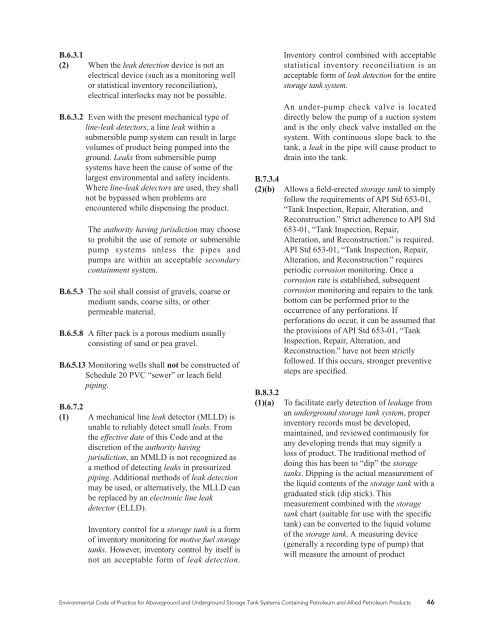Environmental Code of Practice for Aboveground and ... - CCME
Environmental Code of Practice for Aboveground and ... - CCME
Environmental Code of Practice for Aboveground and ... - CCME
You also want an ePaper? Increase the reach of your titles
YUMPU automatically turns print PDFs into web optimized ePapers that Google loves.
B.6.3.1<br />
(2) When the leak detection device is not an<br />
electrical device (such as a monitoring well<br />
or statistical inventory reconciliation),<br />
electrical interlocks may not be possible.<br />
B.6.3.2 Even with the present mechanical type <strong>of</strong><br />
line-leak detectors, a line leak within a<br />
submersible pump system can result in large<br />
volumes <strong>of</strong> product being pumped into the<br />
ground. Leaks from submersible pump<br />
systems have been the cause <strong>of</strong> some <strong>of</strong> the<br />
largest environmental <strong>and</strong> safety incidents.<br />
Where line-leak detectors are used, they shall<br />
not be bypassed when problems are<br />
encountered while dispensing the product.<br />
The authority having jurisdiction may choose<br />
to prohibit the use <strong>of</strong> remote or submersible<br />
pump systems unless the pipes <strong>and</strong><br />
pumps are within an acceptable secondary<br />
containment system.<br />
B.6.5.3 The soil shall consist <strong>of</strong> gravels, coarse or<br />
medium s<strong>and</strong>s, coarse silts, or other<br />
permeable material.<br />
B.6.5.8 A filter pack is a porous medium usually<br />
consisting <strong>of</strong> s<strong>and</strong> or pea gravel.<br />
B.6.5.13 Monitoring wells shall not be constructed <strong>of</strong><br />
Schedule 20 PVC “sewer” or leach field<br />
piping.<br />
B.6.7.2<br />
(1) A mechanical line leak detector (MLLD) is<br />
unable to reliably detect small leaks. From<br />
the effective date <strong>of</strong> this <strong>Code</strong> <strong>and</strong> at the<br />
discretion <strong>of</strong> the authority having<br />
jurisdiction, an MMLD is not recognized as<br />
a method <strong>of</strong> detecting leaks in pressurized<br />
piping. Additional methods <strong>of</strong> leak detection<br />
may be used, or alternatively, the MLLD can<br />
be replaced by an electronic line leak<br />
detector (ELLD).<br />
Inventory control <strong>for</strong> a storage tank is a <strong>for</strong>m<br />
<strong>of</strong> inventory monitoring <strong>for</strong> motive fuel storage<br />
tanks. However, inventory control by itself is<br />
not an acceptable <strong>for</strong>m <strong>of</strong> leak detection.<br />
Inventory control combined with acceptable<br />
statistical inventory reconciliation is an<br />
acceptable <strong>for</strong>m <strong>of</strong> leak detection <strong>for</strong> the entire<br />
storage tank system.<br />
An under-pump check valve is located<br />
directly below the pump <strong>of</strong> a suction system<br />
<strong>and</strong> is the only check valve installed on the<br />
system. With continuous slope back to the<br />
tank, a leak in the pipe will cause product to<br />
drain into the tank.<br />
B.7.3.4<br />
(2)(b) Allows a field-erected storage tank to simply<br />
follow the requirements <strong>of</strong> API Std 653-01,<br />
“Tank Inspection, Repair, Alteration, <strong>and</strong><br />
Reconstruction.” Strict adherence to API Std<br />
653-01, “Tank Inspection, Repair,<br />
Alteration, <strong>and</strong> Reconstruction.” is required.<br />
API Std 653-01, “Tank Inspection, Repair,<br />
Alteration, <strong>and</strong> Reconstruction.” requires<br />
periodic corrosion monitoring. Once a<br />
corrosion rate is established, subsequent<br />
corrosion monitoring <strong>and</strong> repairs to the tank<br />
bottom can be per<strong>for</strong>med prior to the<br />
occurrence <strong>of</strong> any per<strong>for</strong>ations. If<br />
per<strong>for</strong>ations do occur, it can be assumed that<br />
the provisions <strong>of</strong> API Std 653-01, “Tank<br />
Inspection, Repair, Alteration, <strong>and</strong><br />
Reconstruction.” have not been strictly<br />
followed. If this occurs, stronger preventive<br />
steps are specified.<br />
B.8.3.2<br />
(1)(a) To facilitate early detection <strong>of</strong> leakage from<br />
an underground storage tank system, proper<br />
inventory records must be developed,<br />
maintained, <strong>and</strong> reviewed continuously <strong>for</strong><br />
any developing trends that may signify a<br />
loss <strong>of</strong> product. The traditional method <strong>of</strong><br />
doing this has been to “dip” the storage<br />
tanks. Dipping is the actual measurement <strong>of</strong><br />
the liquid contents <strong>of</strong> the storage tank with a<br />
graduated stick (dip stick). This<br />
measurement combined with the storage<br />
tank chart (suitable <strong>for</strong> use with the specific<br />
tank) can be converted to the liquid volume<br />
<strong>of</strong> the storage tank. A measuring device<br />
(generally a recording type <strong>of</strong> pump) that<br />
will measure the amount <strong>of</strong> product<br />
<strong>Environmental</strong> <strong>Code</strong> <strong>of</strong> <strong>Practice</strong> <strong>for</strong> <strong>Aboveground</strong> <strong>and</strong> Underground Storage Tank Systems Containing Petroleum <strong>and</strong> Allied Petroleum Products 46

















